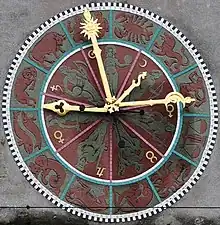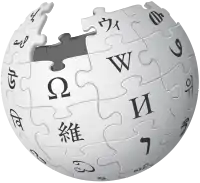♀
.svg.png.webp) | ||||||||
| ||||||||

Classical form of the symbol
Translingual
Etymology
A (copper/bronze) handmirror, symbol of the Greek goddess Aphrodite (and her Roman equivalent Venus). The cross was added in the 16th century to Christianize the symbol of a pagan god.
Symbol
♀︎
- (biology) female.
- 1961 August 17, New Scientist, volume 11, number 248 (in English), Reed Business Information, →ISSN, page 413:
- In his Mantissa Plantarum (1767) and Mantissa Plantarum altera (1771), [Linnaeus] regularly used ♂, ♀ and ☿ for male, female and hermaphrodite flowers respectively.
- 1990, Charles S. Churcher, “Cranial Appendages of Giraffoidea”, George A. Bubenik, Anthony B. Bubenik, Horns, Pronghorns, and Antlers: Evolution, Morphology, Physiology, and Social Significance, New York: Springer-Verlag, →ISBN, chapter 1.5, page 183:
- Figure 2. Ossicones, secondary ossification, and sinuses of Giraffa: A Lateral aspect of skull showing courses of veins, areas of dense ossification (heavily stippled) and lesser secondary ossification (lightly stippled), and outlines of skull roofs of male (♂) and female (♀) adults. (After Spinage 1968b.)
- 2015 July 6, Andy Burns, “Re: C4 last leg”, in uk.tech.broadcast (Usenet, in English):
- I was quite surprised that a few of my friends found the male ♂ (mars) and female ♀ (venus) symbols on toilets in pubs/bars confusing ...
-
- (botany, of a flower) pistillate, carpellate.
- (astronomy, astrology) Venus.
- (alchemy, archaic) copper.
- (rare) Friday.
- Refers to the Latin phrase dies Veneris, which literally means "Venus's day".

Use of ♀ for Friday, on the left side of the calendar dial of this 13th-century clock tower.
| Text style | Emoji style |
|---|---|
| ♀︎ | ♀️ |
| Note: Character's appearance may be different on each system. Text style is forced with ︎ and emoji style with ️ | |
Antonyms
- (biology): ♂
Derived terms
- (alchemy): 🜠 – copper ore.
- (gender): ⚢ – lesbian.
- ⚤ – heterosexual.
- (botany): ♀-♂ – monoecious.
- ♀:♂ – dioecious.
Related terms
| Planetary symbols |
|---|
| Gender and sexuality symbols |
|---|
See also
 Gender symbol on Wikipedia.Wikipedia
Gender symbol on Wikipedia.Wikipedia
This article is issued from Wiktionary. The text is licensed under Creative Commons - Attribution - Sharealike. Additional terms may apply for the media files.